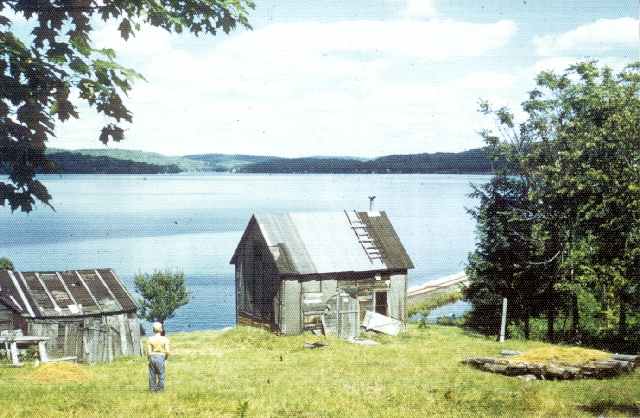The first hunter/gatherers at the lake were aboriginal people of the Algonquin nation. They named the lake Kaijick Manitou after their chief, meaning "Cedar Spirit".
The lake was renamed Loon Lake and then Long Lake, by the white surveyors.
Native families such as Bernard, Lavallee and Baptiste were some of the first settlers. Of these, Algonquin Chief Jean Baptiste and his family are believed to be the earliest resident. Hence the village and lake were named Baptiste.
Read more historical information by clicking on the topic of your choice below:
Birch Cliff History,
Early Settlers,
Bancroft Railway,
Dams on the Lake,
Logging Operations
Artists on The lake,
Old L'Amable,
Rangers Lodge,
Paddy Cox Story ,
Baptiste Memories
Finding Paddy Cox by Peter Brown, July 2000
As a youngster spending summer holidays at Baptiste Lake, I learned all of the important geographical names including Paddy Cox's Bay. I accepted them as names and little more. I knew that an old man named Paddy Cox had lived on the south side of the bay named after him. And from our dock on the east shore, the fabulous hills surrounding his bay and the dancing sunlight on the water have been a never ending delight.
Then early this spring I was struck by Barney Moorhouse's Times Traveller reference to Paddy Cox being at Baptiste Lake in 1915. I realized that I knew far too little about the man after whom this beautiful spot is named. But with a few questions to Jack Cox, his son now 91 years of age and Jack's wife Tina 93, I found out a good deal in less than an hour.
Paddy was brought to Canada from Ireland at the age of 8, with a sister Melinda and brother Jack, by their father who left them to be adopted. Paddy was taken in the by the Louis Levesque family at Greenview. Paddy's wife was Matilda (Tillie) Bowers from Whitney and a sister to Dave Bowers who settled and farmed at Bowers Point on Baptiste and on land back over the mountain.
The Cox's had nine children. They were Nick, Joe, Mary, Jack and Margaret the twins born in 1909 at Mud Creek, Patrick, Kate, Violet and Winnie. Sometime in the interval between 1909 and 1915, they settled in the house in the picture. A man named Haskell Sweet had first staked out the land claim on both sides of the bay, but abandonned it and Paddy and Tillie took it over. Paddy worked at general labour in the mills and on the railways, but suffered an injury to one hand, which ended this source of income. He then filled in anywhere that he could. They kept some cows, pigs and hens. This was a life so hard, it's difficult for us to even imagine. They were over a mile by foot along the railway tracks from Baptiste Village and roads of any kind. Their house was not much more than tarpaper and a roof. In winter, they burned a quarter of a cord of wood each day. Jack says they ate a lot of fish, and an occasional rabbit they might snare. Berries in season were eaten or sold to cottagers.
In spite of their isolated location, Baptiste village was their community. Eva Holbrook recalls Paddy and Tillie visiting often with her parents Hugh and Beatrice Peever and that the kids mixed with the others for card games and the like.
In 1947, famous Canadian painter David Milne first came to Baptiste and Paddy Cox offered him all the land around the bay plus the mountain too for $1,000. The purchase was out of reach but Milne painted the mountain later and called it Thousand Dollar Mountain. Today, it is part of the gallery collection in Vancouver.
By 1950, Paddy and Tillie, now getting on in years, had left Baptiste to live with their son Jack in Bancroft. They both lived well into their 90's passing on in the early 1960's.
Paddy left hardship in Ireland for hardship in Ontario but his name will be remembered by many generations who will continue to enjoy the beauty of Paddy Cox's Bay.
Peter Brown is a grandson of Tom Maxwell and Marion Reid who built their cottage at Baptiste in 1914.
Photo of a young Peter Brown at the former home of Paddy Cox circa 1952.
 <
<
48 Wineva Ave
Toronto, Ontario M4E 2T2
© All Rights Reserved.
